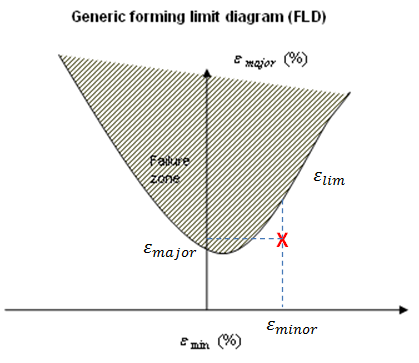/ANIM/SHELL/IDPLY/DAMA
Engine Keyword Generates animation files containing damage values for shell elements that use ply based composite properties, /PROP/STACK (TYPE17), /PROP/TYPE51, or /PCOMPP. The damage value is the maximum of damage over time and of all failure criteria associated to the material.
Format
/ANIM/SHELL/IDPLY/DAMA/Keyword5/Keyword6
Definitions
Comments
- Ply ID number is prop_ID from /PROP/TYPE19 (PLY)/prop_ID or ply_ID from /PLY/ply_ID.
- For fully integrated BATOZ shells, Ishell=12, the value output is the maximum value of the in-plane Gauss points for a particular through the thickness integration point.
- This applies only to failure criteria defined with /FAIL keywords. Failure defined inside material laws (/MAT/GURSON) is currently not available.
- The
damage value, D is the maximum value of all failure criteria of the
model. The damage value which is displayed is the maximum damage value over
time.
In case of composite shell element property TYPE51, the damage value for one ply is computed as the maximum value over the all integration points of its ply.
(1) - The damage
value, D is 0 ≤ D ≤ 1. The status for fracture is:
Free, if 0 ≤ D < 1
Failure, if D = 1
- D is
computed for every failure criteria as follows:
- Strain based failure (/FAIL/BIQUAD)
(2) - Johnson-Cook failure (/FAIL/JOHNSON)
(3) - Tuler-Butcher failure (/FAIL/TBUTCHER)
(4) - Wilkins failure (/FAIL/WILKINS)
(5) - FLD failure (/FAIL/FLD)
(6)
Where,- Strain limit from FLD function

Figure 1.- BAO-XUE-Wierzbicki failure (/FAIL/WIERZBICKI)
(7) - Strain failure model (/FAIL/TENSSTRAIN)
(8) - Strain failure model (/FAIL/FABRIC)
(9) - Energy density failure model (/FAIL/ENERGY):
(10) - Chang failure (/FAIL/CHANG)The maximum damage for different failure mode:
(11) - Hashin Composite failure (/FAIL/HASHIN)
The maximum damage for different failure mode
For uni-directional lamina model:(12) For fabric lamina model:(13) - Puck Composite failure (/FAIL/PUCK) The maximum damage for different failure mode:
(14) - Strain Failure Model with dependence on Lode angle (/FAIL/TAB1)
(15) - NXT Failure Model (/FAIL/NXT)
(16)
- Strain based failure (/FAIL/BIQUAD)